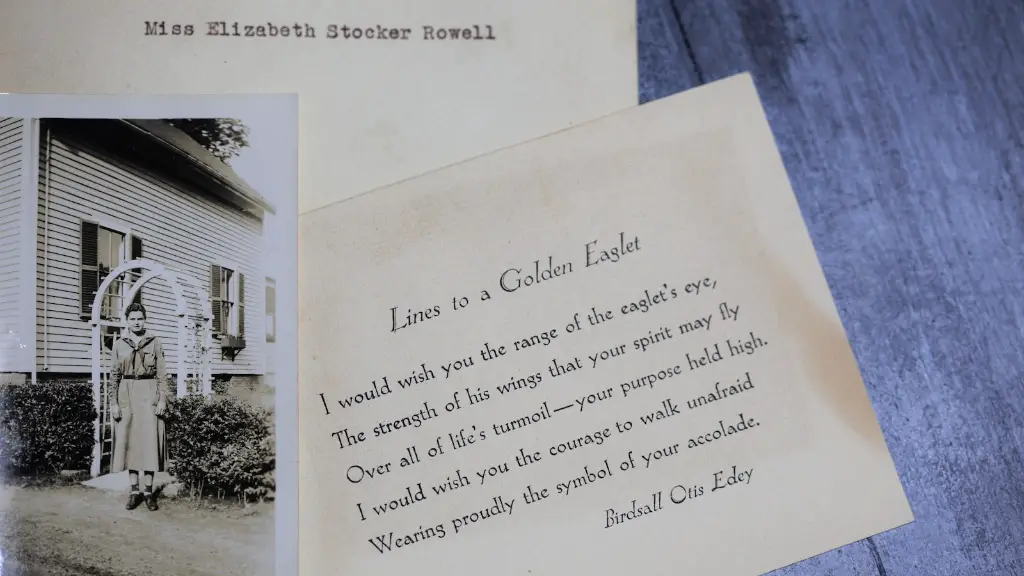Compression in poetry is a technique used to communicate large amounts of information in a limited space. It involves condensing the poet’s thoughts, ideas, and expressions into concise language, emphasizing the essential elements and eliminating the unnecessary. By sharing a wealth of information in a few words, poems can be made more powerful and vivid. Through this practice, poetry has a deeper impact on the reader. There are a variety of techniques used to achieve this, such as using alliteration, metaphors, repetition and assonance.
Alliteration
Alliteration is a technique used to bring emphasis to a particular word or phrase within the poem. It is created by the repetition of the same consonant sound at the beginning of one or more words in the same line or sentence. By emphasizing a single word or phrase, the writer can draw attention to the main idea or focus of the poem. For example, in the poem “The Sound of Silence” by Paul Simon, the phrase “broken bells” stands out due to its alliteration. The repetition of the ‘b’ sound creates an image of broken bells ringing in one’s ears and brings greater impact to the poem.
Metaphors
Metaphors are comparisons between two dissimilar objects, creatures or concepts that illustrate a powerful common connection between them. By connecting elements in unexpected ways, the poet can create striking images that bring many aspects of the poem to life in fewer words. For example, in the poem “The Road Not Taken” by Robert Frost, the metaphor of the two roads being life choices emphasizes the difficulty of making decisions. Without this metaphor, the poem’s impact would not be as deep.
Repetition
Repetition is another technique used in poetry to bring emphasis to a particular word or phrase. It involves repeating the same words, phrases or ideas throughout the poem. By repeating certain words and phrases, the reader is able to better understand and remember the main idea of the poem. For example, in the poem “Do Not Go Gentle into that Good Night” by Dylan Thomas, the phrases “Do not go gentle into that good night” and “Rage, rage against the dying of the light” are repeated throughout, emphasizing the main theme of the poem.
Assonance
Assonance is a technique used in poetry to create a smooth and pleasant sound. It involves repeating a vowel sound at the beginning or end of words to create a musical quality within the poem. This technique is often used to emphasize particular words and ideas within the poem. For example, in the poem “Annabel Lee” by Edgar Allan Poe, the repetition of the ‘e’ sound creates a pleasant sound and emphasizes the nouns in the poem: “annabel lee” and “maiden ne’er parft”.
Combining Techniques
Compression in poetry often involves combining different techniques to create a powerful and vivid image in a limited space. By combining alliteration, metaphors, repetition and assonance, the poet can create an image that is more vivid and memorable than one created with a single technique. For example, in the poem “Stopping by Woods on a Snowy Evening” by Robert Frost, the alliteration of the ‘s’ and ‘w’ sounds in the line “The woods are lovely, dark and deep” is combined with the metaphor of the woods being a place of solace and peace to create a vivid image that speaks to the reader.
Efficacy of Compression
Compression in poetry is an effective way to communicate a wealth of information in a limited space. By condensing the poet’s ideas into concise language and emphasizing the essential elements, poems can be made more powerful and vivid. Through the use of techniques such as alliteration, metaphors, repetition, and assonance, the poet is able to create an image that resonates with the reader.
Analysis of Compression
The efficacy of compression in poetry is demonstrated through its ability to communicate information in a limited space. By combining different techniques, the poet is able to create an image that speaks to the reader in fewer words. This is particularly useful in today’s world where people are more likely to be distracted by competing sources of information. By using compression, poets can communicate a great deal in fewer words and hold their audience’s attention.
Applying Compression
When using compression in poetry, it is important to be deliberate and thoughtful. Choosing the right words and techniques is essential in order to effectively convey the poet’s message. It is also important to consider the context in which the poem is being read. This can help determine which techniques are the most effective in creating an emotional response in the reader. By applying compression in a thoughtful and intentional manner, poets can create powerful and vivid images in their work.
Criticism of Compression
Though compression in poetry can be effective, it can also be too restrictive for some poets. By having to condense the poet’s thoughts into a limited space, the poet may not be able to fully explore their ideas or express them in the way they’d like. Additionally, some readers may find the use of certain techniques, such as alliteration and assonance, to be distracting. For these reasons, there can be criticism of the use of compression in poetry.
Consequences of Compression
The consequences of using compression in poetry can vary depending on the context in which the poem is being read. In some cases, the poem may be more concise and powerful due to the use of techniques such as alliteration, metaphors, repetition and assonance. However, in other cases, the poem may become too restricted and may not fully explore the poet’s ideas. Additionally, some readers may be turned off by the use of certain techniques, such as alliteration and assonance.
Evolution of Compression
Through the years, the use of compression in poetry has evolved. Modern poets are often more deliberate in their use of techniques such as alliteration, metaphors, repetition and assonance in order to make their poems more powerful and vivid. Additionally, poets are increasingly aware of their audience and the context in which their work is being read. They use compression to enhance the message of the poem and ensure that their work resonates with the reader.
Impact of Compression
Overall, compression in poetry can have a great impact on the reader. By using techniques such as alliteration, metaphors, repetition, and assonance, the poet is able to create powerful and vivid images in their work. In a world where people are faced with competing sources of information, compression is an effective way to communicate ideas in fewer words and hold the reader’s attention. By applying compression in a thoughtful and intentional manner, poets can create powerful and lasting images in their work.



